EY’s Global Real Estate Leader Trex Morris discusses how their agile and tech-savvy space has created a more efficient and flexible work environment for employees – both inside and outside the office.

Bob Fox: Tell us a bit about EY.
Trex Morris: EY’s unique quality goes into the way that we way go about looking at our space, our culture, our people, and the way we organize ourselves. We’re in almost all key geographies around the world, with locations in more than 150 countries, we have a total of 700 offices globally, and approximately 260,000 employees that fall within the Millennial age range on average.
With locations in all major metropolitan areas, we view ourselves as an employer of choice who’s after the best and the brightest, and envision that, by 2020, 80 percent of our people will either be Gen Y’s or Gen Z’s.
A little about what helped frame our approach to our real estate solution is aligning the way our business goes to market. We’re heavily focused on our Vision2020 Initiative – being close to our clients and providing them with the best help we can give with our overall theme as building a better working world, and if you’re a real estate person, what a better mantra to have a vision in building a better working world.
We value being people led, living our values through our people, and our purpose through this better working world and creating a culture of high performing teams that don’t necessarily have to be sitting next to you in a work environment. Colleagues could be across the globe for all that matters and it’s being able to connect everyone from around the globe whether that is through infrastructure or technology.

We created a program called EY@Work about four or five years ago and we called it our “Workplace in the Future”. It has continued to transform, but it was a huge transformation program. It really aligned, what I call, our real estate, our HR, and our IT functions across the globe. It recognized where each one was in its own transformation and then asked the question of “How are we positioning this EY@Work experience to enhance all of these different strategies that have already been executed?”
In the old days, I would always sit back and say real estate sat in a silo, our HR team would sit in a silo, and IT was a collaborative effort aligning these strategies to work very close with each other. It’s not only about looking at how we’re operating today but more importantly how we want to operate in the future.
When we talked about EY@WORK, it was really about creating a more efficient and flexible work environment for our people both inside and outside the office.
Our people are enabled to work anywhere. Anytime they need to be connected and anytime they need to connect with their clients or their teammates, they have that right support to do that. When we look at our inside-the-office environment, it’s a mix. You hear lots of companies talking about having a total open environment and others having the old cubicles, however, we like to think we have a mix of open areas, individual work areas, collaboration rooms, private spaces, and informal seating to really map out how people are working today. For example, our offices aren’t assigned seating, they’re unassigned, but if you’re going to be in it for a period of time we have the technology that gives you that flexibility to sign up for a portion of that space. Our truly agile space gives people a choice and allows them to make these connections, decisions and hopefully enhancements by all the robust technology that sits within all of our EY@Work environments.
Technology is a huge enabler in the workplace. Can you describe a little about how technology is used in your space?
So, we talked about an agile work environment. We let people make the choice that suits their task or activity, making sure they have the right space, making sure its efficient and more importantly giving the ability to understand what kinds of spaces are being occupied are what kinds are not. What continues to go back into all of our research is this analysis that says these are the types of spaces our people gravitate towards and these are the ones that are not. Do we do the right change efforts? Do they really understand how that space is supposed to work? And if it’s not being used then let’s reconsider why we introduced it in the first place. I think we got a lot more data points than we’ve ever had, respecting privacy and all of the things out there that we all need to be concerned about. We have a good understanding of how people are operating within the office and what elements are being utilized, so we’ll only get better data as we look ahead.

The technologies are very much focused on enhancing the experience of our people, so if you don’t have an assigned space how do you get connected to the people, but again more importantly, if those people aren’t in the office how do you get connected? If they’re outside the office, if they’re at a client location, if they’re around the globe, how do you make it easy for them to connect? So again, the technology goes from base hardware that is part of our load sets at EY, to leveraging Skype technology so people can have direct interactions that may not be face-to-face, and to leveraging the technologies within our space to help them connect whether that’s through tele-presence or through surface hubs that we’re now leveraging across the globe. This allows people to have these interactions that they can’t have face-to-face, or that touchability.
In our vision of that, yes, we’ve got way-finding, we’ve got ways to connect to our people and find our people in a secured environment but moving forward we’re starting to turn to mobile apps that enhance the experience more prominently.
Let people know about things they need to know around a building. Give them insight into traffic conditions or weather conditions or if you have a threat to the building that you need to keep up with. That’s where we’re heading, and it made us focus on that sooner because of our desire to have our people operate more flexibly and, again, part of that reason for operating more flexibly is that commute time that all of us are encountering as we go along. We want to make them more productive even before they get into the EY office.
So, we’ve got video conferencing, we’ve got video chatting, we’ve got Wi-Fi for the entire office, we’re using smart boards, and we’ve got interactive booking systems. Our ability to notice more and more traction, we’re starting to also work with some of the buildings smart technologies, that will again, give our people a more enriched environment not only within the EY office but outside that broader range, whether that’s associated retail and all the amenities we like around our space such as food services allows for people to stay better connected so that when people are having to go between the blur of the work environment and non-work environment we make that as easy as possible for them.
Amenities are often discussed in the commercial real estate world. What are the most valuable amenities your location can offer from an EY perspective?
We still believe “location, location, location” is primo. You’ve got to have a building in the right location, that’s the starting point. It must be easy to get to/from home and to clients and hopefully connected to transit. Then, if you’ve got the right amenity base, it enhances the appeal and desirability of a location to support our people. The continued focus on work life balance means a richer amenity base and a landlord who understand the impact it has on its tenants and actions it is most valued.

Continued focus on work life balance also means addressing well-being which includes a concierge, a workout facility, food choices, hopefully healthy, amenities that make day to day life easier like laundry, sundry shops, even nail care and massages. We are just trying to take away some of the stresses that are outside the office. We actually have a checklist that helps us differentiate ourselves, and again, if we are trying to be an employer of choice we’ve got to make that experience engaging and free of friction getting to, operating in and departing our EY office.
The remote worker is another issue our readers struggle with. What percentage of EY remote workers do you have in any given day?
What I can tell you, on any given day, we have somewhere between 40 to 60 percent of our people working outside the office. When I say outside the office, they may be at a client location, working from home, or in transit, but they’re not in the EY office. This is across all of our service lines and across all of our sectors and each one is a little bit different so, in some, they may be in the office more.
Can you share a little bit about the technology you described and how these people connect? Are you using any apps like slack?
My own team uses Slack quite a bit. We use Slack to create a way of connecting yet provide a formal platform for our people to stay better engaged. We also use things like Yammer, Skype, texting, and video blogs.
The workplace is a unique aspect when compared to remote workers. Where do people get the biggest advantage from physically being in the EY workspace?
In the old days, you had to come into the office to be productive and in today’s environment, we can have the best and the brightest minds connect from all over the globe. You no longer have to sit next to the person to drive all of that and, with all of that, we’re just trying to enable this to happen the easiest. When I think about the EY@Work locations, we have between 125,000 and 150,000 people working in these almost 200 EY@Work offices around the globe. What we’ve actually seen with the introduction of EY@Work is people actually going into the office more, not less. Compared to their old environments, there may have been lots of cubicles, break ups, partitions, walls, and offices. Now, when you go into the office you can feel the buzz, you can feel the energy.
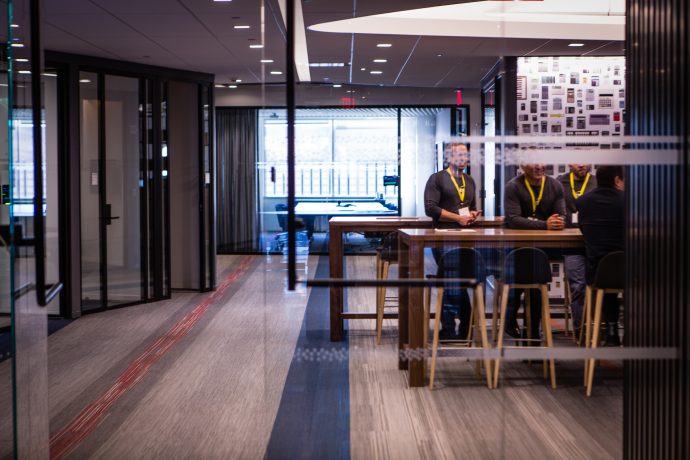
You can actually connect with the people because they’re very visible as opposed to being behind all the barriers. We like bringing outside light into our space, which slows down the ability for you to put lots of walls up, although again we’ve got walls, they’re just not as many as in the old environments. We’ve actually seen our people show up more in the offices. We are creating a lot more common and shared space to support engaging teams and yet providing privacy and heads down choices when that is required. To get the types of amenities and location requirements, you would typically find EY in one of the nicer buildings in typically urban locations. The focus is on giving them an environment that they can’t get elsewhere, making it easier for our people to get to and as a result, people do come in and benefit from the experience and make the connections required to support their clients and their teammates
What’s the biggest value in your workplace?
We’ve actually seen engagement scores go up, so to me that’s the best thing that we can do or say. We like to think it enables our team to perform even better at a higher level. Our occupancy cost has actually stayed flat, as we’ve maintained the investments we’re making and adding the number of people we’ve added. Employment engagement has gone up four points, workplace satisfaction is up 10 percentage points, all while accommodating a significant headcount growth since we’ve executed on the deployment of EY@Work. Making these big investments, maintaining our foot print, all the while providing more efficiency out of space usage and creating more buzz and powerful meaning to it to draw people into the office like a magnet.
What investments are you making? Where are you spending money?
The investments made are significantly more now than before EY@Work. Our cost per square foot continue to go up as we invest in more technology, wellness and invest in providing more choices in seating environments. Things like quality of the space, trying to be more mindful of wellness for our people such as sit-to-stand desks, the investment of WiFi in the space so people can connect easily, being respectful and mindful of the security within our space and making that an easy experience when people come in, and the reservation system that enables people to find others relatively easy are some of those things. Most recently, the development of a mobile app that provides insights into the EY space, the building and the nearby community.
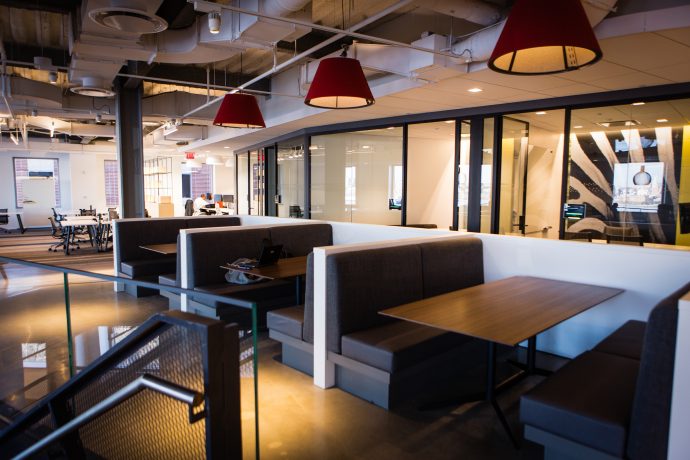
For wellness, we’ve got work areas where you can get on a treadmill to listen to a call or participate very slightly to a call for wellness. We find vertical transportation more and more important so when we’re in buildings, we’re embracing stairwells to better connect our people.
Wellness is a huge emerging topic for Work Design. How are you guys approaching it and ways of measuring its biggest benefits?
We have not started measuring our building portfolio from a wellness standpoint. We do have some examples where we have achieved Well Building certification most recently in Toronto. We still try to balance the effort and costs to do certifications. However, we are committed to embed health, well-being and comfort initiatives within our global EY@Work program. We are aware of the criteria and we are trying to stay aligned to that. We’ve made significant investments in the sit-to-stand desks, providing stairwells not only to connect our people but to encourage a more active work experience, healthy food choices and being mindful of the air quality are included in our well-being approach.
Do you have any biophilia, meditation spaces, or mindfulness programs?
Yes, to all of that. What you see in lots of our spaces are huge investments in the biophilia movement. It adds a different element to our offices in so many ways. We’re very much focused on area like the meditation rooms where people can just get away and refresh themselves or are not feeling well can go in and hopefully recover.
We talked earlier about productivity, and how higher engagement is leading to greater productivity. What’s your way of measuring it?
We have tried to figure it out. We know it has a positive impact and we do try to align it to higher performing teams and better engaging teams, but when I try to extrapolate off of that and put a dollar to it I get people to poke a hole at it.
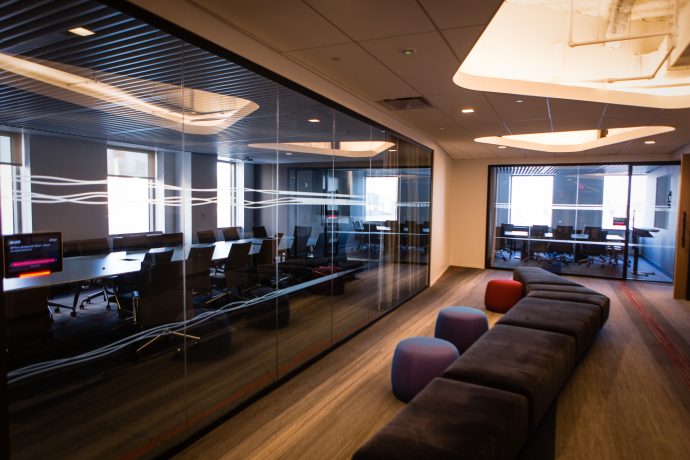
You guys have huge amounts of space to manage and I imagine you’re looking out that next big thing. What do you look at and what do you see happening in the future?
A couple of things I’d like to highlight and a key thing for us is always looking ahead. Looking as far as the business can see and trying to look further than that I think is one of the biggest things our team focuses on in terms of providing flexibility. Providing flexibility in the environments we’re creating, providing flexibility in the commitments we’re making, and in the approach to our needs.
We’ve been introducing co-working globally to EY. It’s probably one percent of our space today but we think its role is even bigger than that.
Is it something you’re using outside co-working locations for or operating internally?
Both. We’ve actually put project teams and leveraged it as overflow. There are five or six reasons we’ve engaged in a co-working environment. One is, we start to manage and reduce our footprint. We see people showing up more often in the office and stay better engaged. Our space doesn’t have the ability to constantly absorb, so as we manage that more effectively, these co-working environments actually provide a key role for those who like working this way. They think what we are creating is very similar to our own EY offices so it’s not like we’re creating anything radically different. This will also create the opportunity for clients coming in to use the space within our own facilities where we’ve leased to create a co-working environment. We’ve done this in a few locations already and seen very positive reaction. I don’t intend for it to necessarily be a recovery, but it has gotten us closer to our clients by making connections with them and it also serves as incubator spaces for other start-ups.
I’m curious about the leases and negotiating with landlords. Are you implementing more flexible terms in those leases?
We’d like to think that we can add to the ups and down of our business in any market we’re in and, again, the local market conditions will dictate what kind of flexibility we have for any negotiation approach and for any location we’re doing. Typically, we do align these by the size of the requirements, so in small locations we have shorter-term commitments as opposed to bigger ones, especially with the kind of investments we make within those spaces. We also may not provide 100 percent of the space, hopefully leveraging some kind of co-working space, as part of that solution.

Anything else you see as changing as you look into the future?
I think, for us, it’s still the technology. Twenty years ago, we went through this phase where we were going to have smart buildings and I don’t think we started to really see these until recently with features coming in such as passive or active sensors and enhancing access with smart phones and leveraging that with other technologies. This will have a tremendous impact for our people to have a great experience. It’s nice to be able to get close to the building and your phone tell you that there is parking available in the building, it’d be nice to be asked without being prompted if we want our cup of coffee made or being notified upon arrival that the rest of your team is in the reserved meeting room. I think that kind of technology will continue to make the experience even better for people and impact the wellness of people. All sorts of information will be available and, how we use it we need to be mindful of. It’s something we will continue to focus on as we look ahead.
Is there anything anyone struggles to adapt to?
Right now, people are generally receptive. Our people have to be viewed as change leaders in everything that they do. It’s also kind of ironic, the number of queries we get from our clients that want us to help them with that have been phenomenal. We created a service to help them with this transformation through change efforts or to sell that to leadership.
Can you highlight or describe the EY@Work program?
Aligning where our tech is going, where our HR policies and real estate is combined, it’s all part of creating an agile and flexible work environment that supports how our people are working. We not only focus how they’re working today but how we think they look as they continue to work ahead into the future.
What’s something that you’re working on with your clients?
As we started this off, I didn’t expect anybody else to work like EY and when we look at this, that’s the first thing you need to do. Understanding where the leadership is trying to take its company and creating a strategy to support that or if you’re feeling like you’re headed down the wrong way then, more importantly, it’s how you get your leadership aligned and you get them to see what you see moving forward. Starting to introduce these technologies to enhance an experience is important in becoming more agile.
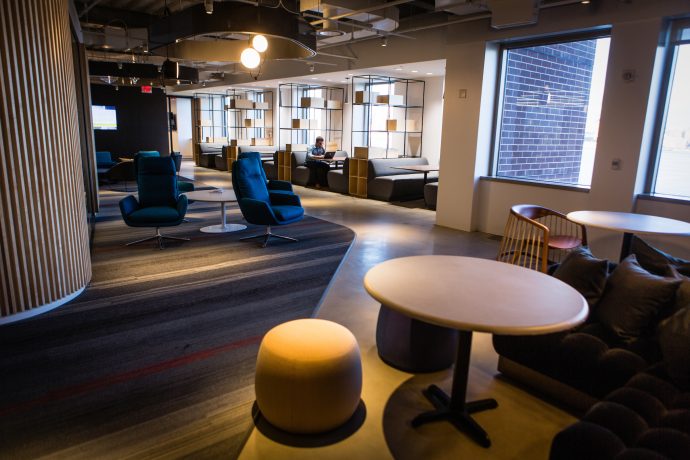
When we started the EY@Work program, we were introducing a pilot, measuring it and determining the benefits. We weren’t necessarily being part of the bleeding edge. We pulled together a lot of data that supported what we needed to change and taking that to let them know what the new world could look like, and if you’re not able to change or adapt, you’re not going to be able to make the investment in the same space and keep the same footprint. How do you leverage all of that into a better story? We didn’t look at it in a real estate silo, we looked at like:
“This is where the real estate platform is going, this is how the tech platform is going, this is how it’s going to make the environment richer in flexibility, and this is what is going to help people be better engaged – so here’s the real estate solution…”
So, it’s all of those elements. We take that thought process with our clients to have these discussions. Sometimes they were in the right track and needed an outside view and sometimes we had a couple of consultants come in and help. Taking a broader approach is what made this successful and it has enabled us to have better discussions with our clients as they see what the new environment looks like.
Any suggestions for any other real estate professionals?
Data is still key. Not being afraid to fail. Stuff doesn’t have to always be developed for you to be viewed as the hero. We saw things going on outside and how it could be applied to EY. It’s important to make that alignment with all functions within a company and getting people on board. Getting leadership involved is also a huge factor because, for us, the leadership we’ve had globally has been phenomenal.

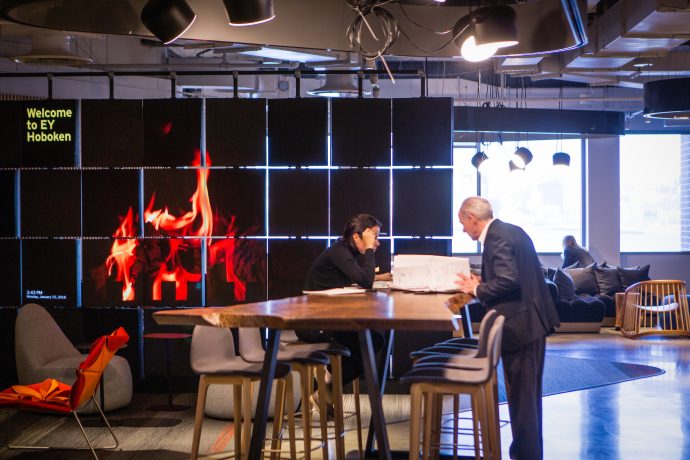

[…] https://workdesign.com/2018/08/interview-ey-trex-morris/ […]
[…] https://workdesign.com/2018/08/interview-ey-trex-morris/ […]